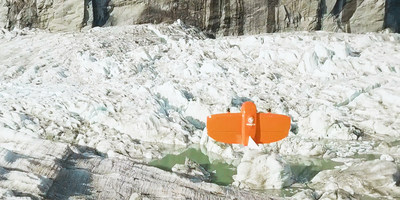A research professor at the University of Alaska Fairbank's Climate Adaptation Science Center, Gabriel Wolken, and his team have been working to visualize and predict the glacial lake's seasonal flux.
They're looking at how the water interacts with the Mendenhall Glacier, which sits next to the basin and holds it together. Mendenhall was once connected to Suicide Glacier before rising temperatures separated them, resulting in Suicide Basin. When basin waters rise to a point, Mendenhall Glacier can't hold them anymore and the entire basin drains, immediately causing flash floods.
"The main issue is that it's ice covered so we can't really see the water as it fills up the basin on a seasonal basis," Wolken explained. That is where the drone data comes in handy. The team uses orthophoto and digital elevation models—from a WingtraOne drone, manufactured by a Swiss robotics company Wingtra—to assess changes to ice levels atop Suicide Basin. This data helps them track the water level and interactions with the Mendenhall glacier.
"Alaska is a big place. There's virtually nothing we address that we consider small here. So if it's going to be a drone, we have to have something that can actually fly for a long time, fly high enough to be able to handle the complex terrain that we're constantly dealing with and provide the resolution that's required for the analyses that we're doing."
According to Wolken, "the WingtraOne drone covers a large area, efficiently and provides data that is high quality in terms of visualization and location accuracy," ultimately offering key insights on the situation.
The flash floods in the Suicide Basin began in 2011, and have damaged infrastructure in the valley several times now.
"This flooding potentially threatens a bridge that is connected to the road system," Wolken said. "And this is the only road that would connect residents on the north side to hospitals and other vital facilities, so if this bridge was impacted it would cause some very serious issues for a lot of people."
Read the full story here.
Video -
https://www.youtube.com/watch?v=UOd2I81Da1M
Photo -
https://mma.prnewswire.com/media/1167932/WingtraOne_Drone.jpg
Logo -
https://mma.prnewswire.com/media/1167933/Wingtra_Logo.jpg
![]() View original content to download multimedia:
http://www.prnewswire.com/news-releases/climate-scientists-use-wingtra-drones-to-predict-flash-flooding-of-alaskan-communities-301059226.html
View original content to download multimedia:
http://www.prnewswire.com/news-releases/climate-scientists-use-wingtra-drones-to-predict-flash-flooding-of-alaskan-communities-301059226.html
SOURCE Wingtra
| Contact: |
| Company Name: Wingtra
Justina Kostinaite, Head of Marketing at Wingtra Email Contact +41774288606 Web: https://wingtra.com |











